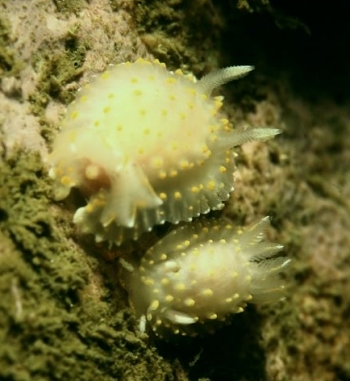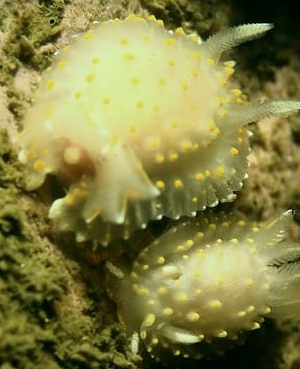
Lophodoris? sp. 1
Suborder: DORIDINA
Superfamily: ANADORIDOIDEA
Family: Goniodorididae
DISTRIBUTION
Known only from Korean coast of Yellow Sea
PHOTO
Locality: Near Tae An city, -10m, South Korea, Yellow Sea, 23 June 2007. Length: Approx. 10 mm. Photographer: Heung Gi Moon.
This species is quite similar to the northern Atlantic species Lophodoris danielsseni in having radiating bundles of spicules around the mantle edge and in having a gap in the mantle skirt in the posterior midline behind the gills and the anus. It differs in having more usual gills, which in L. danielsseni are much reduced and are tipped with a swollen sac of unknown function.
The anterior end also differs from L. danielsseni. It seems that the mantle finishes alongside the rhinophores and the head has a wide oral veil which extends on each side into a tentacle (lined with white), more like in Lophodoris scala.
Authorship detailsRudman, W.B., 2007 (July 20) Lophodoris? sp. 1 [In] Sea Slug Forum. Australian Museum, Sydney. Available from http://www.seaslugforum.net/find/lophsp1
Related messages
Lophodoris sp. ? from Yellow Sea
July 21, 2007
From: Dong Bum Koh


Dear Bill,
Long time no see!
I would like to introduce one seaslug from the Korean coast of the Yellow Sea. It looks the same as the animal in my my previous message #16960 which you thought might be a species of Lophodoris sp?
Locality: Near Tae An city, -10m, South Korea, Yellow Sea, 23 June 2007. Length: Approx. 10mm. Photographer: Heung Gi Moon.
I have no idea about it.
Could you give an ID for me?
Best regards,
Dong Bum Koh
drkoh@seasee.co.kr
Koh, D. B., 2007 (Jul 21) Lophodoris sp. ? from Yellow Sea. [Message in] Sea Slug Forum. Australian Museum, Sydney. Available from http://www.seaslugforum.net/find/20203
Dear Koh,
Thanks for some more interesting photos. This certainly looks the same as your earlier animal. I had hoped after your last message that we might have got some comments from researchers working on the northern Atlantic fauna which is the home of Lophodoris danielsseni. Your animal is similar in having the radiating bundles of mantle spicules around the edge and in having the gap in the mantle in the posterior midline behind the gills and anus. It differs in having more usual gills, rather than the gills of L. danielsseni which are much reduced and each tipped with a swollen sac of unknown function.
The anterior end also differs in your species. It seems the anterior end of the mantle finishes alongside the rhinophores and the head has a wide oral veil which extends on each side into a tentacle (lined with white), more like in Lophodoris scala. However I would need a look at the underside of the animal to be sure.
Whatever this turns out to be, it is quite unusual.
Best wishes,
Bill Rudman
Nudibranchs from the Yellow Sea - Lophodoris sp?
June 29, 2006
From: Dong Bum Koh

Dear Bill,
Sea slugs from the Yellow Sea (between China & Korea) are not well-known either locally or worldwide because of the poor visibility & very strong currents, which means divers dilike diving there. However the fauna is very interesting to us.
Last weekend, a co-worker of mine was diving in theYellow Sea, and took several photos of nudibranchs, whicj I will post in separate messages. I think this animal is Cadlina sagamiensis.
Locality: Gogunsan islands, [Diving site : E 126°4' N 35°8'] 10m, Korea, Yellow Sea, 18 June 2006. Length: unknown. Photographer: Sung Soon Choi.
Best regards.
Dong Bum Koh
drkoh@seasee.co.kr


Dear Koh,
I wondered while looking at your book why the Yellow Sea coast was not represented. It will be interesting to see just what interesting animals turn up there.
I am pretty sure this animal, although similar in colour to Cadlina sagamiensis, is not that species. I suspect this is a goniodorid, perhaps a species of the genus Lophodoris. I can't be sure, but the rhinophores don't seem to have a pocket into which they can contract, and the head has a pair of flattened rounded lobes [lower left photo]. Also in the lower right photo I have included a closeup of part of the mantle skirt which shows bundles of spicules radiating out to the edge as in Lophodoris danielsseni.
Whatever it turns out to be it is an interesting find. If you have other photos of it, I would like to see them, as they may give us more clues to its identity. If this is a species of Lophodoris, I am pretty sure no other species has been reported from anywhere in the Pacific.
Best wishes,
Bill Rudman
